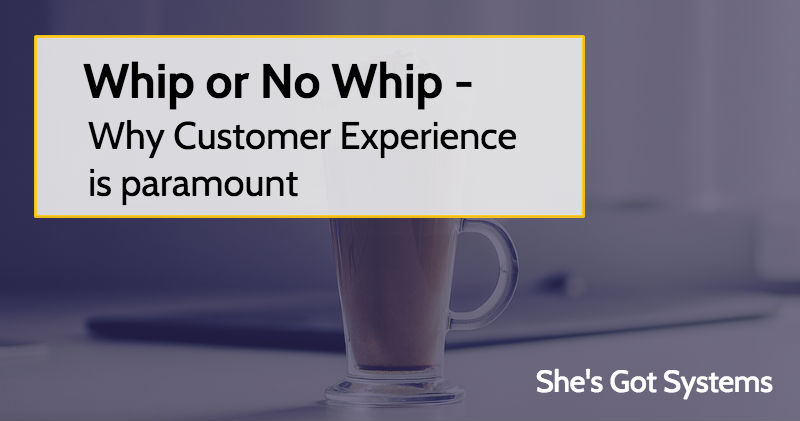{True story: The original title of this blog was: Creating an awesome customer experience until I wrote the following line “record your customer’s preferences around your service (email vs. phone calls, whip or no whip)” and in my defense, I WAS THINKING ABOUT COFFEE. But it was too hilarious not to include, hence the new title.}
It’s the holiday season and while some people think that it’s the most wonderful time of the year, it’s also a time for increased crowds, traffic in the shops, and online shopping. No matter what time of year, the customer experience that a business cultivates will often outlast the purchase.
Today I’ll be using a typical store experience to teach you 5 ways that you can design an awesome customer experience for your online or virtual business. We’ll also have a bonus swipe file for you.
Walking in the door
For a physical store, how someone enters the shop is a chance at the first impression, so from the cheerful “hello” to a carefully placed table of sale items, the store must be designed to welcome and encourage traffic.
Too many websites need to take a lesson from Ikea and learn how to direct traffic. Often there’s hidden or no navigation, unclear page titles, a cluttered sidebar and even so many popups that you can’t see the actual page.
While some people hate the forced flow of an Ikea store, it’s both predictable and useful for directing large volumes of visitors to the right departments.
How does your website welcome and direct traffic, especially new visitors who don’t know their way around just yet? I’ve been thinking about this often as we work on a website redesign and, just like at a mall, if it’s unclear then people are going to walk away.
In today’s Swipe File you’ll find a 7-point checklist for your website to see how easily you’re conveying your message.
Selecting a purchase
We’ve all been there when the website shows something in stock or you just need a ladder to get that item off the top shelf and there’s no one around. Even worse, you have a specific question and no one seems to know the answer.
There’s also a problem of too much information, when a sales person assumes you’re an idiot and asks juvenile, insulting questions.
{My own personal hell is Home Depot when I am purchasing supplies for a project and get man-splaining for 15 minutes – or until I walk away.}
When it comes time to make a decision on a purchase, there’s a fine line between helpful and hovering and another between giving space and abandoning the customer.
In your online store or business, you’ll need to make resources readily available to answer questions – such as live chat, a phone number leads can call, and an email account that actually delivers quick responses. If you don’t have these in place, then you’re likely to get questions coming in on blog comments, on Twitter, posted on Facebook, or in long rants on personal blogs.
Be sure that you’re giving space for the conversation because, unlike a physical store, it’s unrealistic to have a staff watching your website to answer questions 24/7. And please keep in mind that a FAQ does not replace actual human interaction.
Building a relationship
Speaking of human interaction, how annoyed would you be if you visited the same café or diner every week and the owner or barista pretended you were a new guest? Even with products and services we use less frequently, we expect a personal touch. Because if you return to the auto shop or dentist office and they don’t know who you are and your history with them, it feels insulting. Rude.
Now, as someone with an imperfect memory around names and people, it’s understandable that you can’t always identify hundreds or thousands of near strangers in an instant. BUT. Your business keeps records, right? If not, it should.
In the service industry there are often little cheats or ways to help along your memory, like a notes field for conversations so you don’t cheerfully ask that customer about her grandparents for years after they’ve passed away (happened to me last week).
At the very least, in your online business there should be a tool for dividing your list between those who have purchased a product or downloaded an offer and those who have not. It’s confusing and annoying to continue to get promotions for services you’ve already said yes to over and over again.
Keeping good notes on leads, customers and clients isn’t just about having good data to better market to them, but in building a relationship of trust. Face it, there’s something nice about having a server remember your preferences and ask about your latest trip or child’s soccer tournament. If someone who walks into your shop is treated exactly the same as if they were a brand new customer somewhere else, what would compel them to return to you?
In this week’s System Swipe file you’ll get my favorite tips on how to record notes on your customers and what things to listen for in conversation.
Checking out
Good news! Your customer has filled their arms or basket with goodies and they’re ready to buy! In a physical store you better bet that the cash register is easily located. Once someone has made a decision, there’s only so long they want to walk around holding something before simply leaving.
In your online business this means that checking out instructions better be simple. Even better, don’t require someone to jump through hoops in order to purchase or ask them 100 inane questions.
Just today as I was picking up a few groceries at the store, I was nearly self-injured after rolling my eyes so frequently at the conversation going on at the register. The cashier was talking about something unrelated to the purchases in such detail that she had slowed down to scanning an item every 30 seconds.
Even if you want to gather ALL THE INFORMATION, first do the job of completing the purchase. In some ways this is easier at a physical location because you can put your items on the conveyer belt and say in one breath, “yes, I found everything, no, I don’t want to sign up for your store credit card, yes, I have a loyalty card, no it’s not my birthday, yes, place the receipt in the bag and no, I don’t need help out. Here’s my card, thank you.”
Online there’s a bunch of box checking and declining upgrades and insisting that you don’t really need insurance and the deal of the day.
Audit your own client’s experience with check out by making a purchase to see how many unnecessary steps can be eliminated and, if you’re worried about turning people away, find out how many leads are abandoning their shopping cart or going to an order page but not completing a purchase.
Following up
While I don’t think that every purchase in the world requires on-going updates, there is something nice about follow up. For example, I don’t require an insurance plan and registration card for a $20 wireless mouse but I do really love the follow up I get after purchasing a custom canvas voucher reminding me to login and upload my images.
Some products lend themselves better to follow up and building a relationship, and this is one area that an online business has an advantage over the physical store.
In most locations, I can walk in and with the power of cash and buy an item without having to share my name, address, email or newsletter preference. By default, those things are needed for an online service or product that will be shipped. So it’s weird when you do give that information and then it’s never used again.
If you’re going to sell something and ask for additional information, be sure to design the follow up process to match. In today’s swipe file, I’ll have some examples that you can use for your own product, program or service.
No matter what you’re selling, if there’s returning customers or new clients, it absolutely matters how you design the whole experience from walking in the door to following up after a purchase. It’s a little more complex for an online business with a virtual door, but our swipe file will get you started designing the best way to interact with your customers. Check it out:
Swipe my Systems for Awesome Customer Experiences
- Is your website user friendly? 7 questions to ask
- Website welcome checklist
- Getting to Know You – how to build a relationship with clients
- Idea for following up post purchase

 You’re (not) Hired!
You’re (not) Hired! Why you need a free offer and how to create one
Why you need a free offer and how to create one Treating Customers like People
Treating Customers like People